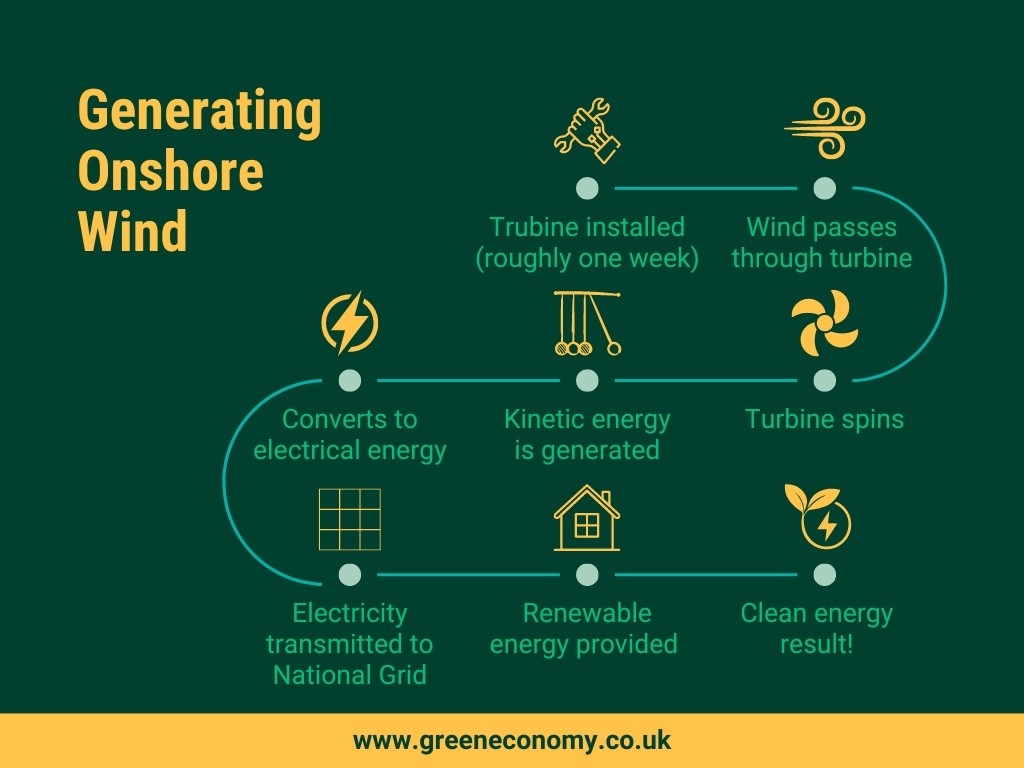
Our Energy Future: Onshore Wind
Read time:
Wind energy represented 15 per cent of Europe’s renewable energy supply in 2022, with capacity increasing further in recent years. Here, we analyse wind technology and its potential to support a clean energy future.
Onshore wind utilises turbines to generate clean energy from the wind. It combines three elements of a turbine: the blades, a box called a nacelle, and a shaft to hold the structure. As wind passes through the blades at the top of the turbine, they spin generating kinetic energy. The generator inside the nacelle in the shaft then converts this kinetic energy into electrical energy.
The majority of wind turbines are either:
Wind turbines generally need winds between 7mphg and 56mph to operate, with efficiency making out around 18mph and reaching a maximum output around 27mph. This means that an excessively windy or stormy day will not necessarily generate more electricity than a day with consistent 27mph winds, for example.
Once the electricity is generated, onshore wind farms are connected to the grid by passing electrical energy through a transformer on site which increases the voltage used by the national electricity system. This is when the electricity moves to the National Grid Transmission Network.


Onshore wind farms involve placing a number of these turbines together to generate larger quantities of renewable energy. You may see individual wind turbines scattered around the UK, or clusters of them together. The UK’s largest onshore windfarm is currently Whitelee, located 20 minutes from Glasgow’s city centre and consisting of 215 turbines and 539 MW installed.
Q: Why are wind turbines white or grey?
A: Wind turbines are most commonly white or grey to make them as visually soft and inoffensive as possible. There have been proposals to paint turbines in certain areas green or blue to match their relative surroundings.
The advantages of onshore wind energy generation are plentiful. Firstly, and most obviously, wind power is a renewable energy source, inexhaustible in its supply and associated with less greenhouse gas emissions than its fossil fuel counterparts. The carbon footprint of a wind turbine is mostly associated with the manufacture, installation and transport of the turbine, equating to around 9g CO2/KWh. This is very low compared to that of a gas generator, which generates around 450g CO2/KWh, and coal which yields a hefty 1,050g CO2/KWh.
Assuming the land is properly managed and maintained, agricultural and stockbreeding activities can be carried out around the turbines. It also takes a relatively short amount of time to erect and take down a wind turbine. One turbine takes about a week to install assuming you’re using an efficient and knowledgeable crew.
One of the primary disadvantages for onshore wind is that it is an intermittent power source, meaning the turbines will only generate electricity if the winds are blowing at the right strength. However, problems of intermittent supply can be overcome by linking with the wind power networks of other countries.
The most common criticism of onshore wind farms is their visual impact, with many critics seeming to prefer the sights and smells of gas and oil refineries. However, 78 per cent of respondents surveyed in spring 2023 said they supported the use of onshore wind in the UK, but just 43 per cent said they would be happy about an onshore wind farm in their local area.
There is evidence to suggest that bird and bat species are impacted by turbines, although the number of bird fatalities because of collision is lower than the numbers compared with bird fatalities from traffic or domestic cats. More importantly, the overall benefits to biodiversity and ecosystems byfitigating climate change through renewable energy solutions outweighs the risks.
The most recent win for UK onshore wind has been the new UK Government’s move to lift the de facto ban as of 8 July 2024. This is a promising move for the UK’s renewable energy sector.
According to the House of Commons Planning for Onshore Wind report, the UK’s installed onshore wind capacity increased by around 11.3GW between 2010 and 2023. By the end of 2023, total installed capacity for onshore wind was 15.4GW. The majority of this, 62 per cent of the UK’s overall installed capacity, is situated in Scotland., followed by 20 per cent in England, and 8 per cent in Wales.
In terms of the UK’s overall renewable energy technology blend, onshore wind made up 26 per cent of this, compared to 24 per cent for offshore wind and 10 per cent for solar PV. As one of the UK’s largest renewable energy sources, onshore wind generated 32.4 TWh of electricity in 2023, equivalent to 24 per cent of all renewable electricity generated in the UK that year and 11 per cent of total electricity generated in the UK.
By the end of 2023, the UK had 758 operational onshore wind farms with over 7,000 active turbines. Now that the de facto ban on onshore wind farms has been lifted, the UK has the potential to progress with the planning and development of further wind farms, placing it on the map as global leaders of renewable wind energy.